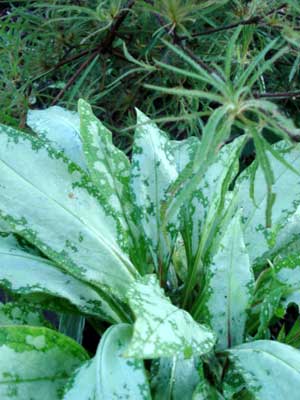
'Silver Bouquet' Bethlehem Sage
or Lungwort
"Of fluent silver, carelessly displayed;
And all the pastures in their morn attire
Of flowery robes most gorgeously arrayed
Shrink now too late before the noonday's fire."
-James Herbert Morse
(1841-1923)
Spotted lungworts had long been a neglected area of potential cultivar development, but since the new millennium, some truly refined hybrids have appeared in the marketplace. One of my favorites is 'Silver Bouquet' which isn't spotted but strikingly silver-leafed with appealing yellow-green mottling & edging.(1841-1923)
It blooms late winter & early spring before the leaves have entirely developed. It's most floriferous here in Zone 8 in April & May, the blooms a rich pink aging to reddish purple. It'll have pink & purple flowers simultaneously for the classic look that gave rise to such folknames as Adam & Eves, Josephs & Maries, Bottle-of-All-Sorts, or Soldiers & Sailors.
It continues blooming while the leaves develop as a perfect fountain of silver foliage. The fountain of leaves easily achieves ten by ten inches. It can be dug up after a few years for division, & lungworts re-establish quickly.
When it's finished flowering, its densely compact foliage continues until autumn as a brilliant spot of silvery "light" in any bright-shade location of a woodland garden. We've mixed them around in a trillium garden, as when the spring trilliums are dying back, the lungworts sustain interest for that area of the garden.
For such a pale leaf, it is surprisingly sun-hardy, & on Puget Sound at least it can take considerable sun, though inland too much sun wouild harm its looks. Pulmonarias suffer if their roots get heated, however, so bright shade is preferred. They'll do almost as well in deeper shade, where they can even be somewhat drought-hardy (though not so in the sun).
They need very little "dressing" & can be ignored (apart from watering) & will keep their tidy look. But sometimes the "cauline" leaves which are the ones that grow on the flower stems fade away when flowers are done, as only the dense floret of basal leaves lasts through summer & autumn. So it doesn't hurt to reach into the clump & pinch out the fading stems of caulines.
It will do well in zones 5 through 9. They prefer to never quite completely dry out between waterings. Though occasional bouts of droughtiness won't necessarily kill it, it could kill its looks. With proper balance of moisture & good drainage, the clumps will remain always free of mildew, no insect problems, not as susceptible to slugs & snails as are hostas, & with a high level of vigor.
This startling plant originated as a seedling in an open field of experimental hybrids. By the plants surrounding it, it seems certainly to have been P. longifolia ssp cevennensis open-pollinated by P. saccharata. It was saved out of the field & reproduced asexually by lungwort & heuchera specialist Janet Egger of Wilsonville, Oregon, & introduced to the nursery trade by Terra Nova in 2009.
P. saccharata x officialis 'Sissinghurst White'